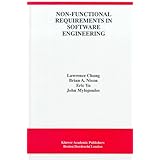
Average Reviews:

(More customer reviews)Are you looking to buy Non-Functional Requirements in Software Engineering (THE KLUWER INTERNATIONAL SERIES IN SOFTWARE ENGINEERING Volume 5)? Here is the right place to find the great deals. we can offer discounts of up to 90% on Non-Functional Requirements in Software Engineering (THE KLUWER INTERNATIONAL SERIES IN SOFTWARE ENGINEERING Volume 5). Check out the link below:
>> Click Here to See Compare Prices and Get the Best Offers
Non-Functional Requirements in Software Engineering (THE KLUWER INTERNATIONAL SERIES IN SOFTWARE ENGINEERING Volume 5) ReviewFrom qualitative analysis to quantitative anlysis it is all there. Non-functional requirements (NFRs) are like the step-child to functional requirmeents but this book finally gives NFRs their due. It is a must read for any person in the software/systems engineering community. Especially impressive is the graphic representations which compliment the text.Non-Functional Requirements in Software Engineering (THE KLUWER INTERNATIONAL SERIES IN SOFTWARE ENGINEERING Volume 5) OverviewNon-Functional Requirements in Software Engineeringpresents a systematic and pragmatic approach to `building qualityinto' software systems. Systems must exhibit software qualityattributes, such as accuracy, performance, security and modifiability.However, such non-functional requirements (NFRs) are difficult toaddress in many projects, even though there are many techniques tomeet functional requirements in order to provide desiredfunctionality. This is particularly true since the NFRs for eachsystem typically interact with each other, have a broad impact on thesystem and may be subjective. To enable developers to systematicallydeal with a system's diverse NFRs, this book presents the NFRFramework. Structured graphical facilities are offered for statingNFRs and managing them by refining and inter-relating NFRs, justifyingdecisions, and determining their impact. Since NFRs might not beabsolutely achieved, they may simply be satisfied sufficiently(`satisficed'). To reflect this, NFRs are represented as `softgoals',whose interdependencies, such as tradeoffs and synergy, are capturedin graphs. The impact of decisions is qualitatively propagated throughthe graph to determine how well a chosen target system satisfices itsNFRs. Throughout development, developers direct the process, usingtheir expertise while being aided by catalogues of knowledge aboutNFRs, development techniques and tradeoffs, which can all be explored,reused and customized. Non-Functional Requirements in Software Engineering demonstratesthe applicability of the NFR Framework to a variety of NFRs, domains,system characteristics and application areas. This will help readersapply the Framework to NFRs and domains of particular interest tothem. Detailed treatments of particular NFRs - accuracy,security and performance requirements - along with treatmentsof NFRs for information systems are presented as specializations ofthe NFR Framework. Case studies of NFRs for a variety of informationsystems include credit card and administrative systems. The use of theFramework for particular application areas is illustrated for softwarearchitecture as well as enterprise modelling. Feedback from domainexperts in industry and government provides an initial evaluation ofthe Framework and some case studies. Drawing on research results fromseveral theses and refereed papers, this book's presentation,terminology and graphical notation have been integrated andillustrated with many figures. Non-Functional Requirements in Software Engineering is anexcellent resource for software engineering practitioners, researchersand students.Want to learn more information about Non-Functional Requirements in Software Engineering (THE KLUWER INTERNATIONAL SERIES IN SOFTWARE ENGINEERING Volume 5)?
>> Click Here to See All Customer Reviews & Ratings Now
0 comments:
Post a Comment